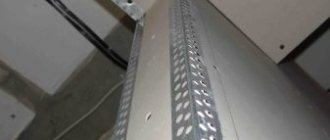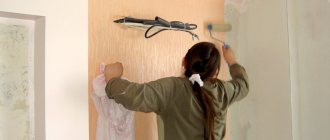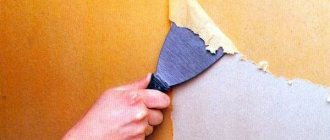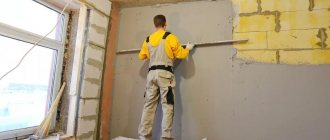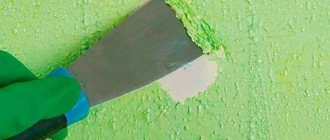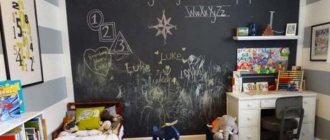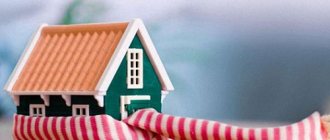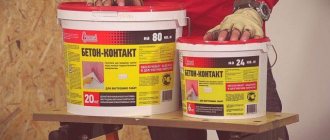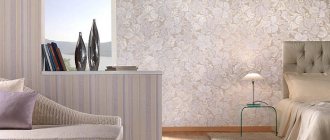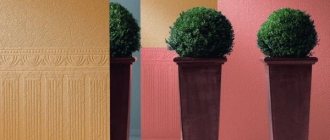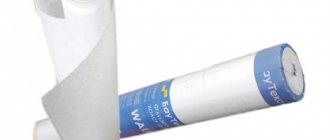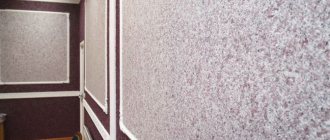Gone are the days when wallpaper was simply glued to the walls of apartments. Now special finishing of the internal walls is being carried out in order to achieve a longer service life of the coating and to make the rooms protected from external sounds and noise. For this purpose, a special wallpaper backing is often used, which is an excellent means for leveling and soundproofing walls from neighbors.
In budget real estate, the walls have poor sound insulation, so it is recommended to use a substrate during renovation, on which the wallpaper will then be glued.
Advantages of substrates
First of all, wall coverings are used to make the room warm and protected from external street noise. Also, wallpaper backings are an excellent material that helps to decorate walls and glue the material evenly. Other advantages of this technology include:
- High degree of strength, so the material will not tear quickly.
- The substrates are made from environmentally friendly materials.
- Prevents the formation of condensation and fungi.
- Creating a comfortable atmosphere in the room.
- Long operating time.
Thus, the range of applications for substrates is varied. The use of the material allows you to solve several problems that are typical for modern apartments and houses.
Types of substrates
The interior decoration of the rooms depends on the type of substrate selected. It is selected based on the following factors:
- The number of residents in an apartment or house.
- Location of housing.
- The influence of temperature, nature and weather conditions.
- Level of humidity and dampness.
There are several types of wallpaper substrates, which are most often used for interior decoration:
- Foamed polyethylene, which has a porous structure, lightness, and low thermal conductivity. This type of substrate is used to create warmth in the apartment. This material allows you to create sound insulation and retains its qualities at temperatures from +60 to +90. You can glue foamed polyethylene to concrete walls, reducing insulation costs. This substrate is sold in rolls.
- Cork backing is made from natural material, therefore it is safe, environmentally friendly, and has an excellent level of sound insulation and adhesion. It is recommended to use for rooms with thin walls, if the “effect” of street noise is constantly present in the house. This will protect your apartment or private house from barking dogs, neighbors’ voices, car horns, and the sounds of repairs from neighboring apartments. Cork is an excellent thermal insulation material, but it is susceptible to moisture and water. Therefore, this type of substrate is not recommended for regions or apartments with a humid climate.
- Non-woven backing is made from modified cellulose, which allows the material to remain resistant to steam. Thanks to this, the normal process of airing and ventilating the walls and removing moisture from living spaces occurs. Non-woven fabric is elastic, which allows it to be used on walls with uneven surfaces.
- Drywall is a hard type of substrate for wallpaper; it is used less often than other materials because it is susceptible to dampness and moisture. When using drywall, you must leave a gap between the wall and the material.
Purpose
The substrate is foamed polyethylene, covered on both sides with paper. In addition to paper, cork or non-woven backing is sometimes used, which have received excellent reviews from customers. This is an excellent material that has a high level of sound insulation and is a thermal insulation coating. The backing is designed for pasting any type of wallpaper directly onto it.
It has a number of advantages:
- it is durable;
- environmentally friendly;
- not susceptible to microorganisms;
- does not absorb moisture and prevents condensation from appearing on the walls;
- soundproof (has a high level of sound insulation).
Thermal and sound insulation are the main advantages of this material
It should be said right away that before gluing the substrate you need to know how to glue it correctly. First you need to prepare the walls. They need to be freed from old wallpaper. Old paint is also removed, and cracks and pits are leveled using putty or cement mortar. The surface is primed; PVA glue or any other wallpaper glue is suitable for this purpose.
The day before pasting the walls, you need to cut the material into pieces according to the size of the walls, let it rest and level out. Smooth sheets should be coated with glue on the inside and allowed to stand for five to ten minutes. Glue is used for gluing polystyrene or heavy wallpaper. The process of gluing the backing is similar to wallpapering. The same technology, only the sheets must be glued end to end.
Removing air bubbles from under the surface is done with a rubber roller. The seams must be sealed with paper tape or narrow paper tape. The next step is to wallpaper the walls, but you need to let the backing dry for at least 1-2 days.
The practicality of the substrate lies in the fact that it does not change its properties for twenty years (some manufacturers guarantee fifty years). This allows you to use the substrate for several repairs, covering it with new wallpaper. This insulating material will protect rooms from the effects of fungus and condensation for several decades, will increase soundproofing and heat transfer, and this will be especially noticeable in those rooms whose walls face the street or common corridors. In addition to all that has been said, the substrate also acts as a leveling material for uneven walls.
Photo: foam
Acoustic wallpaper
On the finishing materials market you can also find a special type of wallpaper - acoustic. They are sold in rolls or slabs, so they are convenient to use for gluing ceilings and walls. Acoustic wallpaper has a high level of sound absorption. Surfaces perfectly reflect sound, resulting in a reverberation effect - sound creates an echo. To achieve this effect, the structure of acoustic materials is made from the following materials:
- Cellulose, i.e. paper. Sometimes it is replaced with non-woven fabric. These materials act as the basis of the wallpaper.
- The outer layer (top) is covered with acrylic fabric or other fibrous materials consisting of fibers. Thanks to this, the fibers absorb sound.
There are acoustic wallpapers made from cork and finishing materials made from wood. In particular, from veneer, from bamboo, from grass. The thickness of the wallpaper is 3-4 mm, which depends on the material.
Soundproof acoustic wallpaper can be used to decorate the following rooms:
- Houses with low levels of sound insulation.
- Cinemas.
- Canteens.
- Bedrooms.
- Meeting rooms.
- Cabinets.
Advantages and disadvantages
Acoustic wallpaper is used for wallpaper substrates, which allows you to create a high-quality level of noise protection in apartments and houses. Other advantages of the material include:
- The backing is very easy and simple to work with, which allows you to cut it into pieces without much effort, as well as gluing it to the walls.
- When gluing, workers will not suffer from dust and odor.
- Environmental friendliness of the material.
- Long service life.
- Moisture resistance.
- Excellent fire characteristics.
- Impact resistance.
Advantages
Building materials intended for rough finishing of partitions simplify the process of gluing wallpaper. In addition, they increase the level of comfort in the room. Some craftsmen also use a backing for decorative work.
Along with the main advantages, the canvases have a number of advantages:
- strength. Resistance to mechanical damage is implied. Thanks to its elasticity, it is invulnerable to tearing;
- made from natural, environmentally friendly raw materials;
- blocks the formation of fungus and mold. Prevents the spread of insects;
- long service life;
- aesthetic appeal that allows you to create comfort;
- the substrate belongs to the budget price segment.
Prices for soundproofing materials and acoustic wallpaper
- The noise-absorbing material, which is created from foam rubber panels, helps to create an excellent acoustic effect in the apartment, its price is 1,535 rubles / package.
- European volumetric wallpaper stickers with a 3D effect - the cost varies from 230 to 29.5 thousand per piece.
- Self-adhesive wallpaper, which is made of foam - the price is 361 rubles / piece.
- Acoustic panel that allows you to create excellent sound insulation - from 111 rubles / piece.
- Acoustic panels made of leather with 3D effect - 21.1 thousand rubles/lot.
- Polyester acoustic wallpaper - from 1.4 thousand to 1,772 rubles / lot.
- Foam acoustic panel - from RUB 1,650.
- Decorative acoustic panels made of leather - from 22.1 thousand/lot.
- Self-adhesive 3D wallpaper “brick-like” - from 525 to 880 rubles/piece.
- PVC for gluing walls - from 153, 562 rubles / lot.
Soundproofing materials that are used to create comfort in an apartment differ in cost and the material from which they are made.
Before purchasing, you need to check with specialists for which room such wallpaper is suitable and whether it can be used as a backing.
Manufacturers
The online store of construction and finishing materials of the Mercury Group of Companies recommends using a base for gluing walls from trusted manufacturers; The most popular brands of goods by customers:
- Polyfom, Globex, Echokit, Penolon.
The backing material Polifom, Globex, Echokit, Penolon is made of hygroscopic polyethylene foam, which on both sides has a special paper coating impregnated with a special composition that provides excellent adhesion to the wall. The thickness ranges from 4-5 millimeters.
Pasting process
The backing is very easy to use, so you won’t have to work hard with it while working. You only need to do the following:
- Completely clear the wall of wallpaper or other material.
- Large cracks and crevices are smoothed out by covering with plaster.
- The wall must be leveled so that there are no large differences due to unevenness. If such a need arises, the wall should be re-primed.
- The wall must be clean and dry.
- The roll of backing is cut into sheets of the length required for gluing. It is worth remembering that for non-woven wallpaper, you buy a special glue for non-woven wallpaper, which is applied only to the wall. For polyethylene foam and cork, glue must be applied to the substrate and the wall. After spreading the glue, wait 3 to 5 minutes for it to dry slightly. This will make it easier to place sheets of material in the desired place on the wall.
- The backing strips must be glued joint to joint, and then the seams must be reinforced with paper tape.
The substrate dries within 72 hours, after which you can begin gluing the wallpaper. This should not be done before, otherwise they will not stick well and “wrinkle”.
It is better to wait a few days until the wallpaper backing is completely dry. To ensure that the wallpapering of the room does not suffer from the poor quality of the work performed, it is not recommended to carry out work at high temperatures. The ideal temperature is +10, so repairs should be done either in spring or autumn. There should be no drafts in the room where they plan to work with the wallpaper backing.
When buying wallpaper, people mainly rely on their beauty, and not everyone thinks about whether they will be combined with the surface on which they are supposed to be glued. Almost all types of this design element can begin to show through over time, and in order to prevent this from happening, a backing or base for the wallpaper must be applied before gluing.
Benefits of use
Wallpaper backing structure
Wallpaper backing structure
The wallpaper backing is made of foamed polyethylene, covered on both sides with paper, non-woven fabric or cork:
| Photo | Name |
| Paper | |
| Non-woven | |
| Cork |
I do not recommend using paper backings in rooms with high humidity, as paper does not tolerate moisture well. Non-woven or cork products are better suited here.
Non-woven backing for wallpaper is better suited for rooms with high humidity than paper
The backing is glued to the wall, and wallpaper is applied on top of it:
Scheme for gluing wallpaper in case of using a backing
This approach to finishing work has its advantages:
- Increases the sound insulation of walls . Complete silence, unfortunately, cannot be achieved, but some of the noise coming from the neighbors can still be stopped;
A soundproofing layer under the decorative trim will make your stay more comfortable
- Provides uniform absorption of glue , thereby eliminating the appearance of bubbles that spoil the appearance of the finish;
- Partially levels the base. Small cracks or chips will be covered;
The substrate hides all minor imperfections of the finished surface
- Makes it easier to apply decorative coatings yourself. This especially applies to corners and joints;
I recommend gluing only thick thick wallpaper over the cover, since it can show through through thin ones.
- Reduces the thermal conductivity of walls . The room will be warmer in winter, and cooler in summer;
Walls with a backing under wallpaper become warmer
- Strengthens adhesion . Wallpaper sticks better to paper than to concrete, brick or plaster;
- Increases the service life of decorative coatings.
Properties of wallpaper bases
In addition to its main function, the base can also perform others, allowing you to increase the comfort in the room and its aesthetics.
- The base smoothes out uneven walls, facilitating further wallpapering.
- Due to the layer between the walls and wallpaper, thermal insulation increases.
- Some types of substrates additionally increase the sound insulation of walls.
- Due to the fact that the entire surface of the base has the same absorbent characteristics, the adhesive is distributed more evenly when applied. The same property ensures uniform drying of the glue over the entire surface and better adhesion.
- When applying wallpaper to a treated surface, it is easier to align their joints.
Paper base
If you paste wallpaper on plaster, small irregularities may appear through them, which remain after applying this material to the wall. The simplest paper base will help eliminate them. It is also called lining wallpaper. This type of substrate perfectly levels out all minor surface imperfections.
A paper backing is also used if there is already wallpaper on the walls, but it is quite difficult to remove it. This material helps save time during repairs, since the thick paper that makes up the base reliably covers the pattern of the old wallpaper. And the stains on the “bare” walls after gluing it will become less noticeable.
Purpose of the base
Wallpaper bases have been used for a long time. About 30 years ago, old newspapers were used for this, and then they were replaced by special paper.
Modern bases for wallpaper are high-tech materials that can not only facilitate the process of wallpapering walls, but also perform the functions of insulation and sound insulation.
Wallpaper backing is a wall covering with insulating properties.
Typically, wallpaper backings are made of polyethylene foam, lined with paper sheets on the back and front sides.
Instead of polyethylene foam, cork or non-woven fabric can be used to make the backing. The backings can be glued under any type of wallpaper.
This finishing material has the following advantages:
- high strength - it is difficult to tear;
- environmental safety;
- prevents condensation;
- serves as sound insulation.
The backing for the wallpaper is a soft roll finish, but despite this, it is highly durable.
There are reviews of the wallpaper backing that say it can withstand several re-pastings of wallpaper. New wallpaper is simply pasted onto the old backing without removing it from the wall.
The material prevents the appearance of mold on the walls and ensures silence in the room. In addition, using a wallpaper backing, you can even out unevenness on the walls.
Professionals increasingly advise sticking wallpaper not on bare walls, but on substrates, since the level of sound insulation in modern apartments leaves much to be desired.
Despite the fact that wallpaper backings are a universal material with many advantages, they also have disadvantages:
- not suitable for wet areas;
- not suitable for thin wallpaper - in this case the backing may show through;
- will not be able to isolate the room from extraneous sounds at high noise levels.
Non-woven base
Non-woven fabric has been on the market for a long time; wallpaper made from this material is the most popular. There are also substrates based on this material. They have the same properties as paper ones, but their strength is an order of magnitude higher.
It's all about the material itself. It is made from special, modified cellulose. It helps to increase not only strength, but also allows the walls to “breathe,” thereby increasing the drying speed of the glue and reducing the possibility of the wallpaper “sliding.”
Cork backing
Cork is rapidly gaining popularity in construction. It is used both as decorative elements and in the form of substrates - both for floors and walls.
Cork has become so widely used due to its superior thermal insulation properties compared to other materials. In addition, due to its structure, this material absorbs noise well. Therefore, it is widely used in residential areas with thin walls, through which cold and extraneous sounds can break through.
To make a backing for wallpaper, a special technical cork is used. To glue it together, special types of glue are used, which increase the strength of the material.
But cork has one property that is not very good for wallpapering. It has very weak adhesion, so before applying wallpaper to the surface, it should be thoroughly primed.
For what reasons did they stick the newspaper?
There are several undeniable advantages of sticking newspapers:
- Since the paper is thin, it quickly sticks to the surface.
- It doesn’t matter what kind of glue you use, the newspaper will still stick perfectly.
- The newspaper sheet is large enough, so the work can be done quickly.
- Quick drying property, so you don't have to wait very long.
- Wallpaper quickly sticks to the paper base, and it can be very difficult to tear it off.
The list of nuances is significant, due to which paper pasting on walls remains relevant today.
Drywall, OSB and plywood
If the walls have strong unevenness, then in order to hide them, it is necessary to use more serious types of substrates. They can be sheet materials with a width of 4 mm or more:
These types of materials will easily hide the imperfections of the walls, but to apply them you will need to build a frame on which they will rest. To construct it, you will need rectangular beams (logs) with a cross-section of 2x4 cm. If the surface has strong convexities, then their dimensions can reach up to 5x5 cm.
The beams are attached to the wall in the form of a lattice using screws and dowels. First, vertical logs are laid; they should be positioned so that when installed, the panel covers half of its width. Next, horizontal bars are applied; they must be placed between the vertical ones. The distance between horizontal joists can vary from 0.3 to 1 m, depending on how wide the bulges in the wall are.
Instead of wooden beams, you can use a U-shaped aluminum profile.
Next, sheets of material are placed on the logs. They are fastened using 16–19 mm self-tapping screws. The distance between the screws should be approximately half a meter, but no more, since if the fasteners are set too widely, the substrate may begin to “walk.”
After the panels are securely fixed to the wall, it is necessary to work out the joints so that they do not show through under the wallpaper. This can be done using putty.
Putty can create additional unevenness, which is why the joints can stand out, especially on light-colored wallpaper without or with a weak pattern. Therefore, it is recommended to combine the panel backing with other types, for example, paper.
You can also increase sound and heat insulation by filling the cavities between the wall and the substrate. This can be done using polyurethane foam. To do this, you need to make two holes in the panels in the space between the joists with a 6 mm drill. They should be located at the top corners of the empty space. Next, you need to pump foam into one of them. This must be done until the foam flows through another hole.
After sealing, you need to wait a day and then close the holes with putty. This solution will preserve heat and prevent extraneous sounds from entering the room.
Soundproofing underlay
In order to reduce the level of noise coming from outside, soundproofing substrates are used in the premises. They are made from foamed polyethylene. This material is located between two layers of durable paper.
This type of insulation is used as a substrate where it is impossible to install soundproofing structures. In addition, it has thermal insulation properties that are quite suitable for interior walls of buildings. Also, this type of base hides wall defects well due to its thickness.
Thermal insulation base
2 types of materials can be used as a basis to prevent the entry of cold:
Putty may contain sawdust or polystyrene; sometimes there are types with mineral fillers. But it takes longer to install as it needs to be applied first and then treated to make the wall smoother.
It is much easier to use a rolled insulation backing. It consists of two layers:
This type of base is quite easy to attach to the wall, as it is self-adhesive. This means that even a child can work with it. Due to the presence of polyethylene foam, this substrate can also perform a soundproofing function and can also smooth out uneven walls.
Installation of the substrate
How to glue the backing to the wall:
- the surface is freed from wallpaper;
- remove water-based paint or whitewash;
- the recesses are leveled with putty or alabaster;
- The wall is primed with PVA glue
- 24 hours before sticking, the backing is cut and allowed to rest on a flat surface.
When working with non-woven backing, glue is applied not to it, but to the walls.
Tip: immediately remove excess glue from the joints with a napkin.
Pasting begins from the window and moves in a circle. At the junction of two walls, the sheets must be end-to-end - pasting a corner with one sheet with a bend is not allowed.
Substrate for liquid wallpaper
The use of standard substrates is not suitable for liquid wallpaper or paint. Even if the walls are uneven and you had to use panels to level them, you still need to apply a special base on top of them. It is necessary in order to reduce the absorption of walls and smooth out color defects.
As a base, it is necessary to putty the wall, after which it is necessary to apply 2 layers of primer.
In order for the wall to have a uniform color over the entire surface, it is recommended to apply white paint to it before painting it in the desired color.
If the wall is made of crumbling concrete, then a special strengthening primer is used for the base, which will prevent further crumbling of the wall during painting.
For each room, it is necessary to choose the most optimal type of wallpaper base so that it combines as many positive qualities as possible. After all, increased thermal insulation is not always required. And external sounds are often practically inaudible in brick houses.
But the use of a backing is still necessary, since it will not be possible to paste wallpaper onto plaster without it. In addition, without it, over time, all the flaws and stains that were on the concrete will appear on the wallpaper.
Why do craftsmen glue paper to walls before wallpaper?
Previously, before wallpapering walls, paper was glued to the base. This method was used during Soviet times. The walls were practically not even, and there was no quality glue . If the surface was clay, then newspapers were glued onto a soap solution.
Advantages of this method:
- Leveling the base, all existing tubercles and pits were smoothed out.
- The clay will not crumble as the surface is tightened.
- If you stick wallpaper on newspapers, they will stick better.
It is worth noting. Under the Soviet Union, they didn’t think much about it, and the paper base ideally replaced the primer.
Insulating backing for wallpaper and its most important properties
A high-quality non-woven backing, laid between the wall and the wallpaper, becomes an insurmountable barrier to moisture, thereby preventing the development of mold. In addition, such material can dampen vibrations and increase the sound insulation of the room.
The insulating backing under the wallpaper also, to a certain extent, prevents heat loss in the room and does not allow cold air from outside to penetrate into the rooms. The degree of insulation depends on the thickness of the material, as well as its quality.
Modern soundproofing wallpaper backing, produced by different manufacturers, may differ in its physical qualities, thickness, length and width of the roll. A high-quality substrate should withstand even heavy wallpaper.
Offers from manufacturers
All prices in the article are current in the summer of 2021.
All substrates have the following qualities:
- Environmental Safety . They do not emit any harmful substances, so they can be used in places where children and allergy sufferers live;
- High insulating properties . Despite the small thickness, not exceeding 5 mm, the glued sheets increase the thermal insulation and sound insulation of the walls;
- High strength characteristics . The material does not tear during gluing.
In a hardware store you can find the following brands of wallpaper backing:
EcoHeat
Due to mechanical production, Ecohit substrate has a uniform and dense structure
| Parameter | Meaning |
| Weight per square meter | 230 g |
| Coefficient of thermal conductivity | 0.037 W/(m×K) |
| Vapor permeability coefficient | 5.38 kg/(m×s×Pa) |
| Breaking force | 0.18 mPa |
| Sound absorption level | 22 dB |
| Flammability level | Flammable material |
| Roll width | 50 cm |
| Roll length | 14 m |
| Roll price | 1585 rubles |
Penolon
Due to the presence of air cells in its structure, foam insulation underlay for wallpaper is distinguished by high thermal insulation properties
| Parameter | Meaning |
| Manufacturer country | Russia |
| Flammability level | Flammable material |
| Blade thickness | 5 mm |
| Roll width | 50 cm |
| Roll length | 14 m |
| Roll price | 1690 rubles |
Polyph
Wall insulation with Polyfom is not only effective, but also profitable from an economic point of view
| Parameter | Meaning |
| Country of manufacture | Russia |
| Weight per square meter | 230 g |
| Breaking force | 0.18 mPa |
| Coefficient of thermal conductivity | 0.043 W/(m×K) |
| Density | 30 kg/m3 |
| Flammability level | G4 |
| Blade thickness | 5 mm |
| Roll width | 50 cm |
| Roll length | 14 m |
| Additional properties |
|
| Roll price | 1400 rubles |
Polyzol
Polyzol is made from cross-linked polyethylene foam and has a closed cell structure
| Parameter | Meaning |
| Weight per square meter | 230 g |
| Coefficient of thermal conductivity | 0.037 W/(m×K) |
| Vapor permeability coefficient | 5.38 kg/(m×s×Pa) |
| Flammability level | Flammable material |
| Blade thickness | 4 mm |
| Roll width | 70 cm |
| Roll length | 10 m |
| Price per square meter | 165 rubles |
Soundproofing backing for wallpaper: how to choose
Nowadays, people purchasing wallpaper for renovation are increasingly deciding to use a backing, which is easiest to purchase using specialized Internet resources. To do this, enter the query “buy wallpaper backing” in the search bar and select a high-quality material from the offered options.
Good backing for wallpaper:
– must demonstrate high moisture, steam, sound and heat insulation properties;
– be environmentally friendly and safe for people, pets, and the environment;
– show resistance to bacterial and fungal infections;
– provide a perfectly flat surface for wallpapering;
– allow for repeated gluing of wallpaper;
– easy to stick, sticks firmly to the walls;
– do not require finishing plastering of the surfaces to be coated.
A soundproofing underlay for wallpaper that meets the characteristics listed above will improve the microclimate in the room being furnished and make the home more comfortable and convenient.
How to glue the backing under the wallpaper?
We don’t have to talk long about how to glue the backing under the wallpaper - this operation is quite simple and does not require specialized construction skills.
Old wallpaper, paint, layers of lime, and other loose materials are removed from the walls being tiled. Identified gaps, cracks and chips must be covered. Then, the walls are primed. The backing cut to size is glued end-to-end using heavy wallpaper glue. Construction tape must be applied over the seams. Wallpapering walls is allowed only after the substrate has completely dried; the drying time is indicated on the packaging of the material. It is allowed to place photo wallpaper on the wall, vinyl and paper sheets, and other types of wallpaper on top of the insulating sheets.
Today on sale are sheets of polyethylene foam, cork backing for wallpaper, and other options for insulating materials.
Application Features
The instructions for applying the substrate are very simple, just follow a number of rules:
- Remove any remaining old trim and loose pieces of plaster. Fill large cracks and chips with putty;
The wall before facing should be as clean as possible and free from damaged areas.
- Prime the wall before gluing the wallpaper under the backing;
The primer will ensure maximum adhesion of the substrate to the wall
- Cut the roll into sheets of the required sizes in advance;
All substrates are very easily cut into fragments of the desired dimensions
- Make sure the room temperature is around +10 degrees Celsius . At a lower temperature, the glue will not be able to gain sufficient strength; at a higher temperature, it will dry out too quickly, not having time to fix all areas of the finishing fabric;
- After applying the glue to the substrate, wait a few minutes until it is well absorbed, and only then apply the canvas to the wall. It is best to use PVA for this purpose, rather than ordinary wallpaper adhesives.
